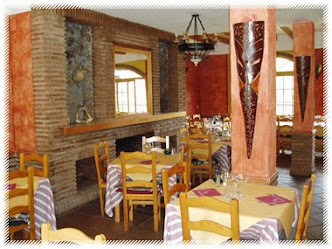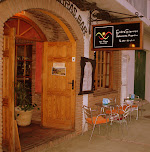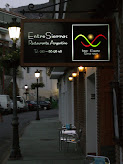
DAMIEN HIRST
Entitled "Cock and Bull," this showpiece by British artist Damien Hirst towers above diners at Tramshed, which only serves chicken and steak.
Internationally renowned British artist Damien Hirst has created an art piece for a London restaurant in which a whole Hereford cow and cockerel are preserved in formaldehyde in a steel and glass tank, smack dab in the middle of the dining room.
Called "Cock and Bull," the showpiece towers above diners at Tramshed which -- surprise -- serves only steak and whole roasted chicken.
Like a giant aquarium mounted on a TV stand, the art installation is an extension of Hirst's Natural History, a collection of preserved animals he's been creating since 1991 -- arguably his most famous series. Hirst also created a painting for the restaurant opening entitled "Beef and Chicken" which hangs on the mezzanine level and depicts the 1990s cartoon characters "Cow and Chicken."
In the basement level, the Cock ‘n' Bull gallery showcases a rotating art exhibit every six weeks. The first exhibition Quantum Jumping features art work themed around "jumping into a parallel dimension," and runs until July 1.
The classically British menu by chef and restaurateur Mark Hix, meanwhile, is conducive to family-style dining with whole roasted, free-range chickens or marbled sirloin steaks, both served with fries. Appetizers include Yorkshire pudding with whipped chicken livers, cauliflower salad, and smoked Cornish mackerel with beets and horseradish.
It's not unusual for restaurants to house the collections of famous and interesting artists, given the synergy between food and ambiance. Pierre Gagnaire's eponymous restaurant, in Paris, for instance, houses works from the Galerie Lelong, while Wolfgang Puck has also turned his restaurant space into an exhibit for a roster of rotating artists at his CUT steakhouse in Los Angeles.
Meanwhile, restaurants like Eric Ripert's Le Bernardin in New York, Jason Atherton's Pollen Street Social in London and Jean-Georges Vongerichten's Spice Market in London have been shortlisted in the Restaurant & Bar Design Awards this year.





 According to Merriam-Webster, ingenuity can be defined as "skill or cleverness in devising or combining" or "cleverness or aptness of design or contrivance." We'd say that's an apt description of a Frenchman named Emile who reportedly found himself stranded in the deserts of Northwest Africa after breaking a frame rail and a suspension swingarm underneath his Citroën 2CV.
According to Merriam-Webster, ingenuity can be defined as "skill or cleverness in devising or combining" or "cleverness or aptness of design or contrivance." We'd say that's an apt description of a Frenchman named Emile who reportedly found himself stranded in the deserts of Northwest Africa after breaking a frame rail and a suspension swingarm underneath his Citroën 2CV.









